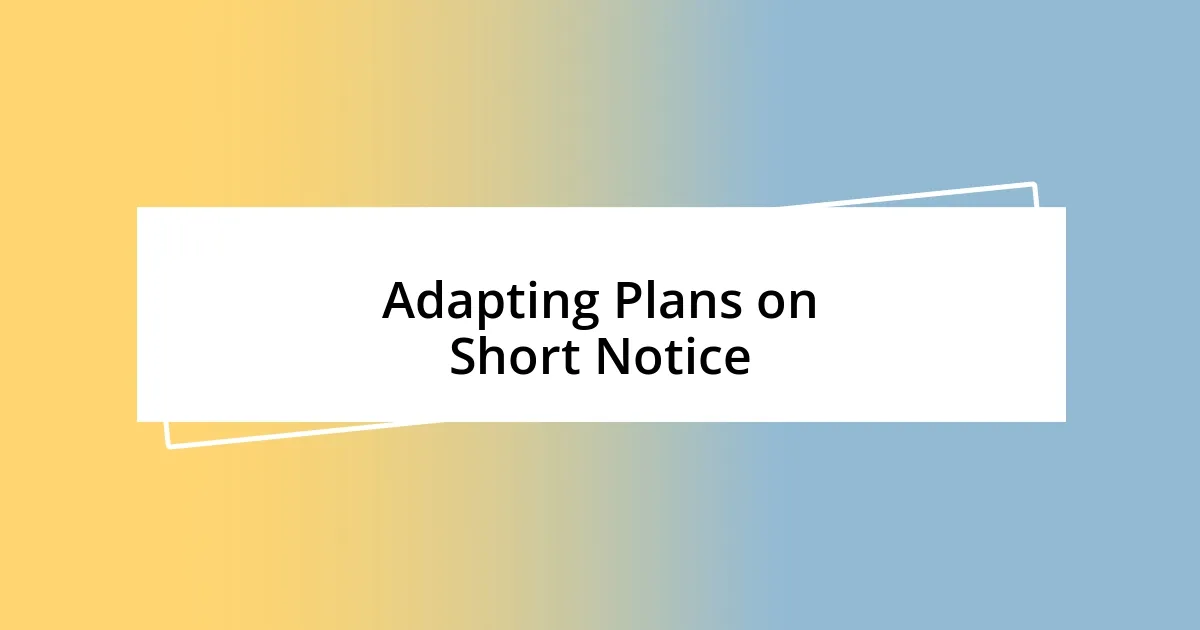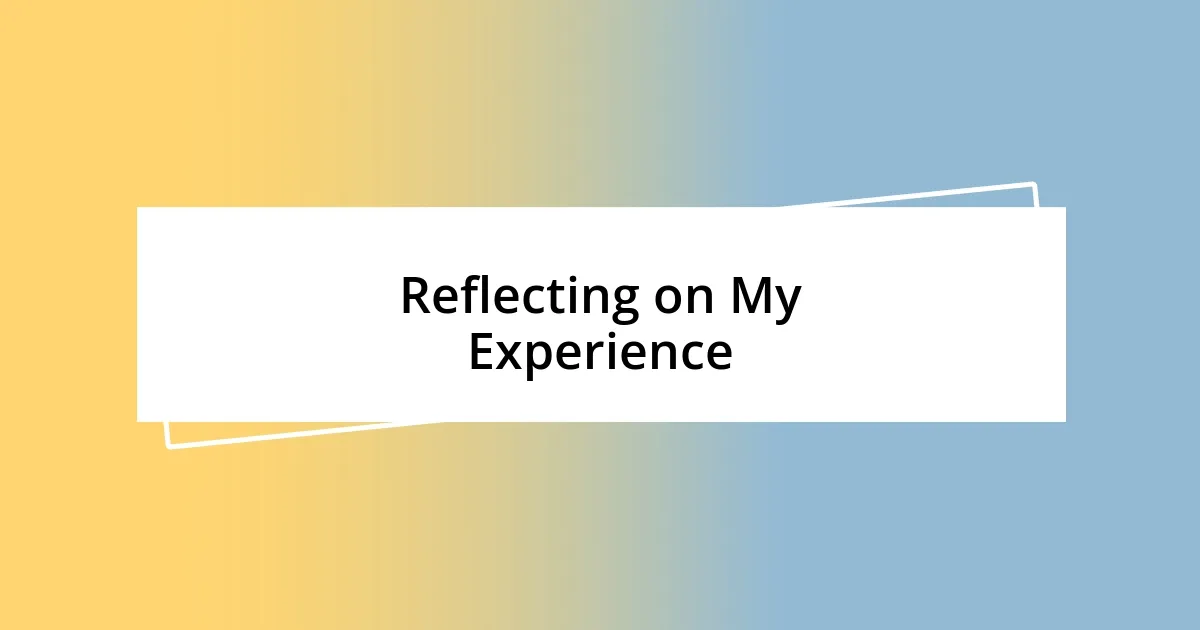Key takeaways:
- Having a comprehensive emergency kit and layered clothing is crucial for unexpected weather events.
- Staying informed through multiple weather sources and alerts can help make quick decisions and ensure safety.
- Flexibility and having backup plans are essential for adapting to sudden weather changes.
- Reflecting on past experiences fosters resilience and strengthens bonds with friends and family during challenges.

Preparing for Unpredictable Weather
When it comes to preparing for unpredictable weather, I’ve learned that having a solid emergency kit can make all the difference. I remember one summer when a sudden storm ripped through our area, knocking out power for days. The feeling of scrambling to find essentials like flashlights, water, and non-perishable food was stress-inducing, and I wished I had been better prepared.
I’ve also realized the importance of keeping an eye on weather forecasts and alerts. It’s easy to become complacent, especially when the prior weeks have been sunny. Have you ever been caught off guard by a sudden change while out and about? I have, and it left me drenched and shivering in minutes. Investing in a good weather app can provide timely updates and keep you informed, empowering you to make quick decisions.
Finally, it’s wise to create a communication plan with family and friends. In one instance, my phone lost battery amid a storm, and I felt utterly disconnected. How would you reach your loved ones if the unexpected hits? I now ensure everyone in my family knows where to meet and how to stay updated if things go sideways. This simple strategy greatly eases anxiety during unpredictable weather.

Understanding Weather Forecasts
Understanding weather forecasts can be a game-changer when dealing with unexpected weather events. I still remember one day when the forecast predicted clear skies, only for a sudden downpour to catch me completely off guard while I was out jogging. I learned then that forecasts are a guide, but they’re never set in stone. The emotions of reliance mixed with frustration in that moment taught me to take them with a pinch of caution and an open mind.
Here are some key elements that I find particularly helpful when interpreting weather forecasts:
- Types of Alerts: Understanding the difference between watches, warnings, and advisories. A watch means conditions could develop, whereas a warning indicates severe weather is imminent.
- Forecast Sources: Relying on multiple sources like local news, weather apps, and online services can give you a well-rounded view of the situation.
- Radar and Maps: Familiarizing yourself with radar images helps visualize storm movement, making it easier to understand how the weather may affect you.
- Trends Over Time: I’ve noticed that looking at a week-long forecast gives better insight than just focusing on daily updates.
- Local Nuances: Weather can differ greatly even within short distances. Knowing the characteristics of your specific local geography can help you better prepare.
I now embrace a proactive approach, checking several forecasts daily, especially when I sense that weather might take a turn. It’s become a small but crucial part of my routine, one that gives me a sense of control over nature’s unpredictability.

Essential Gear for Weather Changes
When it comes to essential gear for weather changes, I’ve found that a versatile wardrobe makes all the difference. I once ventured into the mountains with nothing but a light jacket, thinking the sunny forecast was foolproof. That day, a cold front moved in, and I was left shivering as the temperature dropped. I learned the hard way that having layers—thermal shirts, waterproof jackets, and a good pair of insulated gloves—can transform a miserable experience into a manageable one.
Additionally, a compact emergency kit can be a lifesaver, particularly during severe weather. After being caught in an unexpected hailstorm on a road trip, I realized how invaluable a roadside emergency kit is. Having tools like a flashlight, a first-aid kit, and even a portable charger for my phone made a significant difference. It took away some of the anxiety of being stranded, knowing I had the basics covered.
Lastly, I now never leave home without a reliable umbrella and a sturdy pair of water-resistant shoes. There was one instance when I was on my way to an important meeting, and out of nowhere, it poured. My regret for not having an umbrella was palpable, leaving me drenched and flustered. I’ve since made it a point to have these items on hand at all times; they help me feel prepared for whatever the weather throws my way.
| Gear Type | Purpose |
|---|---|
| Layered Clothing | To adapt to temperature changes easily |
| Emergency Kit | To be prepared for unexpected situations |
| Reliable Umbrella | To shield from rain and stay dry |
| Water-resistant Shoes | To ensure comfort during wet conditions |

Adapting Plans on Short Notice
Adapting plans on short notice is often where my resilience is truly tested. I remember one time when I had carefully arranged a picnic with friends. Just as we were about to leave, the sky darkened unexpectedly, and rain started pouring down. In that moment, instead of canceling, I suggested we move the gathering to my living room. We transformed a potentially disappointing day into a cozy indoor picnic, complete with blankets and snacks. It reminded me that flexibility can turn a curveball into a delightful experience.
I’ve also noticed that having a backup plan you believe in gives you peace of mind. There was a hiking trip once where rain was forecasted, but my friends insisted on going anyway. I packed a portable game set, just in case we had to seek shelter. Sure enough, a sudden storm hit, and while we huddled under a tree, we ended up laughing and playing games. How often do we allow a twist of fate to derail our intentions? My experience proved that even amidst the chaos, a little creativity can keep the spirit of the original plan alive.
Another important aspect I’ve learned is to stay connected with others. Whether it’s family or friends, communicating plans allows for rapid adjustments. I recall a camping trip where one of my friends had an urgent work matter crop up last minute. Instead of canceling the whole outing, we convened a quick call to strategize. We decided the rest of us would still go and send updates on our adventure, keeping him in the loop. This not only maintained our plans but also reinforced our bond. Ultimately, adapting isn’t just about what you decide to do; it’s about how you make space for everyone involved.

Staying Safe During Severe Weather
When dealing with severe weather, the most important thing I’ve learned is to always stay informed. On one occasion, a thunderstorm popped up while I was out hiking. Thankfully, I had my weather app set to send me alerts. As soon as I got a notification about lightning in the area, I made the decision to head back to my car. It was a harrowing walk, but knowing I was one step ahead made all the difference. Would you trust yourself to act quickly if a situation like this arose?
Another key aspect of staying safe during severe weather is knowing your shelter options. During a particularly intense snowstorm, I was stuck in a small town with rising snowbanks. I remember locating a local café that stayed open late and hunkering down there with a warm cup of coffee. It was comforting to be surrounded by others clearly in the same boat, sharing stories and keeping each other entertained. Have you ever had to seek refuge unexpectedly? It’s fascinating how adversity draws people together.
Lastly, I’ve come to appreciate the value of preparation before severe weather hits. One year, when hurricane season approached, I took the time to stock up on essentials like water, non-perishable food, and even some board games to pass the time with family. The peace of mind that came with knowing I was prepared for anything was simply invaluable. I often wonder, how ready are we really for the unexpected? Taking that proactive approach not only kept me safe but also fostered a stronger sense of community with neighbors, as we shared tips and resources.

Reflecting on My Experience
Reflecting on my experiences with unexpected weather brings back a whirlwind of emotions. I recall a spontaneous camping trip that turned into a chilly night under unexpected rain. We’d set up camp with excitement, only to find ourselves jokingly huddled together in my tent, sharing stories while the rain drummed on the roof. It struck me then just how much laughter can comfort us in the midst of nature’s unpredictability. Isn’t it incredible how a slight shift in plans can open the door to cherished memories?
Another moment stands out, too—the time I found myself in a sun-drenched park when dark clouds began to gather. I hesitated for a moment, torn between enjoying the sun and taking precautions. But the ominous change felt like an invitation to reflect on life’s uncertainty. I rushed to pack my things, but instead of seeing it as a setback, I embraced the thrill of the looming storm. Have you ever felt that electric anticipation before a downpour? It reminded me that sometimes, it’s all about seizing the moment, even if it’s fleeting.
Lastly, I’ve often contemplated how these experiences shape my overall outlook. The unpredictability of weather has taught me resilience, but more importantly, it has deepened my appreciation for those I share these adventures with. Facing a storm, whether alone or with friends, can evoke feelings of vulnerability, yet it’s those shared moments of discomfort that often create the strongest bonds. Have you ever thought about how adversity can strengthen your relationships? I find that reflecting on these times fills me with gratitude and connects me to others in a way that sunny days sometimes can’t.

Lessons Learned for Future Emergencies
I learned the hard way that having an emergency kit ready is non-negotiable. During a freak hailstorm, my car got pelted, forcing me to take shelter in a nearby gas station. Fortunately, a kind employee shared their stash of flashlights and blankets, which made the experience a bit more bearable. Honestly, I wish I had been better prepared. Are you equipped to handle such surprises?
Another lesson that resonated with me is the importance of having a communication plan. When a sudden blizzard hit while I was out with friends, we got separated trying to make our way to safety. Relying on our phones, we struggled with poor service, feeling increasingly anxious. That day, we realized that having an agreed-upon meeting point or check-in times can save a lot of stress. How would you reconnect with loved ones in an emergency?
I also discovered that staying flexible is key when weather conditions change unexpectedly. Last summer, I had to adapt my weekend plans when thunderstorms rolled in. After initially feeling disappointed, I decided to host a spontaneous indoor picnic instead. We laughed, played games, and found joy in the moment rather than fretting about the canceled plans. Doesn’t it feel good to turn a challenging situation into an opportunity for creativity? Embracing adaptability can transform how we face weather-related disruptions.














